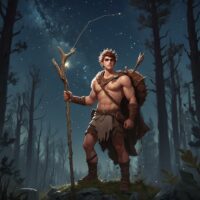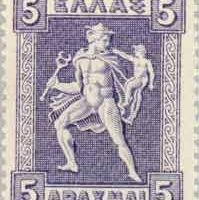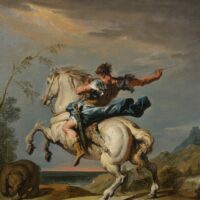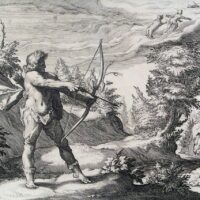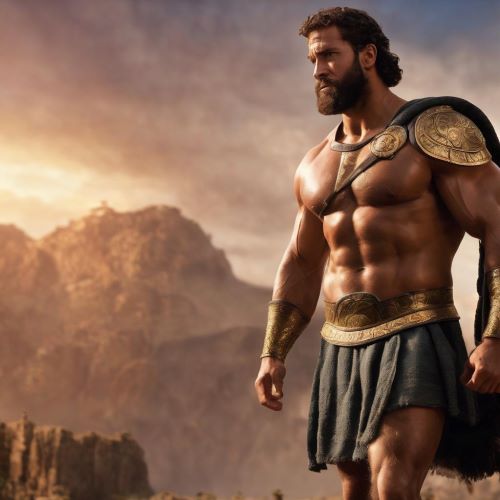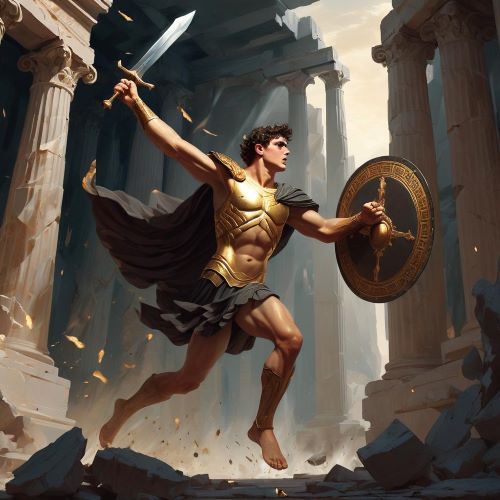Arcas : The Arcadian Hero
Listen
At a glance
| Description | |
|---|---|
| Origin | Greek Mythology |
| Classification | Demigods |
| Family Members | Zeus (Father), Callisto (Mother), Elatus, Apheidas, Azan (Children) |
| Region | Greece |
| Associated With | Hunting |
Arcas
Introduction
Arcas, a significant figure in Greek mythology, stands as both a legendary king and the namesake of Arcadia. His tale is a blend of divine heritage, tragic transformations, and cultural innovation that shaped the identity of an entire region. Born of Zeus and the nymph Callisto, his life was touched by jealousy, betrayal, and celestial destiny. Callisto, once a follower of Artemis who had pledged chastity, was transformed into a bear—either by Hera, in her rage, or by Zeus to conceal their union. Arcas survived this turmoil and was entrusted to Maia, the mother of Hermes, who nurtured him into adulthood. His story took dramatic turns, from being served unknowingly to Zeus by his grandfather Lycaon, to being saved from killing his own mother, and finally being placed among the stars. As king of Arcadia, Arcas gave his people knowledge that transformed their way of life, leaving behind a legacy rooted in myth, geography, and cultural memory.
Physical Traits
Ancient sources offer few direct descriptions of Arcas’s appearance, but as the son of Zeus and a nymph, he is imagined to embody the archetype of a demigod. His reputation as Arcadia’s greatest hunter suggests a strong, agile build capable of enduring the demands of survival in a rugged landscape. Mythological art often presents him in the rustic attire of Arcadian hunters, such as simple tunics or animal skins, reflecting his close bond with the wilderness. In celestial imagery, Arcas is linked to constellations like Boötes or Ursa Minor, where he is sometimes depicted with a staff or plow, symbolizing both his hunting skill and his contributions to agriculture. These representations emphasize his dual role as both a man of the wild and a civilizing figure.
Family
Arcas’s family connections weave together mortal and divine elements, creating a genealogy filled with both honor and tragedy. His father was Zeus, the ruler of Olympus, and his mother was Callisto, a nymph of Artemis’s retinue whose life was shattered by transformation. His maternal grandfather was King Lycaon of Arcadia, infamous for testing Zeus by offering him human flesh, an act that nearly cost Arcas his life. After his rescue, Arcas was fostered by Maia, who protected and raised him away from Hera’s wrath.
As an adult, Arcas’s marital connections vary across traditions. Some sources name his wife as Erato, a sea-nymph, while others cite Laodamia, Meganeira, or Chrysopeleia. His children carried forward his legacy and ruled different parts of Arcadia. Among his most recognized sons were Elatus, Apheidas, and Azan, who each became regional leaders. Other accounts list additional offspring such as Autolaus, Hyperippe, Diomeneia, Triphylus, and Erymanthus, broadening the dynastic reach of his lineage. Through his descendants, Arcas was seen as the progenitor of the Arcadian people, giving mythological depth to their identity.
Other names
While the figure is best known as Arcas, Greek sources sometimes refer to him under alternative spellings, including Arkas. In astronomical contexts, he is often associated with Boötes, a constellation linked to his myth. This name highlights his celestial role as a guardian figure, often depicted as a herdsman or plowman in the night sky. Although the epithet “Arcas” is also applied in some traditions to Hermes, it is important to distinguish this from the myth of Zeus’s son, whose legacy is tied specifically to Arcadia and its origins.
Powers and Abilities
Arcas was not an Olympian god, but his myth attributes to him a set of skills and symbolic powers that shaped the Arcadian way of life. His foremost reputation was as a hunter of great skill, a talent inherited from Callisto. This ability reflects both his survivalist upbringing and his connection to the wild landscapes of Arcadia. Beyond hunting, Arcas is remembered for introducing agriculture to his people. Ancient writers credit him with teaching the art of bread-making and weaving, skills that transitioned Arcadians from nomadic herders to a settled, agrarian society. These contributions earned him a place not just as a king but as a cultural innovator.
A dramatic moment in his myth centers on his transformation. When Arcas nearly killed his mother in her bear form, Zeus intervened, changing him into a bear as well to prevent tragedy. Both mother and son were immortalized as constellations, often identified as Ursa Major and Ursa Minor. In other traditions, Arcas was placed in the sky as Boötes, forever guarding his mother. These transformations elevated him from a mortal ruler to a figure of celestial permanence, ensuring his legacy extended beyond earthly reign.
Modern Day Influence
The myth of Arcas continues to echo through multiple fields, showing how ancient stories retain cultural weight in the present. Astronomy preserves his name and role through the constellations Boötes and Ursa Minor, both of which are key markers in the night sky. The star Arcturus, one of the brightest visible from Earth, is often associated with him, its name meaning “Guardian of the Bear,” a clear link to his myth with Callisto.
In literature and art, Arcas’s narrative offers a tapestry of themes—divine betrayal, transformation, and human resilience—that remain relevant. Classical works like Ovid’s Metamorphoses preserve his story, while Renaissance and Romantic interpretations of Arcadia turned his homeland into a symbol of pastoral harmony and idyllic beauty. The idea of “Arcadia” as a utopian landscape owes much to the myth of Arcas, blending historical geography with poetic imagination.
Cultural identity also draws strength from his name. Arcadia, named for Arcas, has become synonymous with natural purity and a retreat from worldly concerns. This symbolism has shaped everything from European landscape painting to philosophical ideals about simplicity and harmony with nature. Even in modern popular culture, though less frequently referenced than other Greek figures, Arcas occasionally appears in fantasy literature and games, where he represents wilderness, transformation, or celestial destiny.
Finally, his role in education and mythology studies remains significant. Arcas’s story provides insight into ancient Greek perspectives on divine-human relationships, the dangers of jealousy, and the symbolic importance of constellations. His myth underscores how narratives of lineage and transformation explained both the natural world and cultural origins for the Greeks, a legacy that continues to fascinate scholars, writers, and storytellers alike.
Related Images
Source
Arcas | Facts, Information, and Mythology – Encyclopedia Mythica. (1997). https://pantheon.org/articles/a/arcas.html
Contributors to Wikimedia projects. (n.d.). Arcas – Wikipedia. https://en.wikipedia.org/wiki/Arcas
Ovid. (2004). Metamorphoses (D. Raeburn, Trans.). Penguin Classics.
Hyginus. (1960). Astronomica (M. Grant, Trans.). University of Kansas Press.
Hard, R. (2004). The Routledge Handbook of Greek Mythology. Routledge.
Tripp, E. (1970). The Meridian Handbook of Classical Mythology. Meridian.
GreekMythology.com. (n.d.). Arcas. https://www.greekmythology.com/Myths/Mortals/Arcas/arcas.html
Theoi.com. (n.d.). Arcas. https://www.theoi.com/Heros/Arkas.html
Allen, R. H. (1899). Star Names: Their Lore and Meaning. G. E. Stechert. https://archive.org/details/starnamestheirlo00alle
Frequently Asked Questions
What is lorem Ipsum?
I am text block. Click edit button to change this text. Lorem ipsum dolor sit amet, consectetur adipiscing elit. Ut elit tellus, luctus nec ullamcorper mattis, pulvinar dapibus leo.
What is lorem Ipsum?
I am text block. Click edit button to change this text. Lorem ipsum dolor sit amet, consectetur adipiscing elit. Ut elit tellus, luctus nec ullamcorper mattis, pulvinar dapibus leo.
What is lorem Ipsum?
I am text block. Click edit button to change this text. Lorem ipsum dolor sit amet, consectetur adipiscing elit. Ut elit tellus, luctus nec ullamcorper mattis, pulvinar dapibus leo.
What is lorem Ipsum?
I am text block. Click edit button to change this text. Lorem ipsum dolor sit amet, consectetur adipiscing elit. Ut elit tellus, luctus nec ullamcorper mattis, pulvinar dapibus leo.
What is lorem Ipsum?
I am text block. Click edit button to change this text. Lorem ipsum dolor sit amet, consectetur adipiscing elit. Ut elit tellus, luctus nec ullamcorper mattis, pulvinar dapibus leo.


